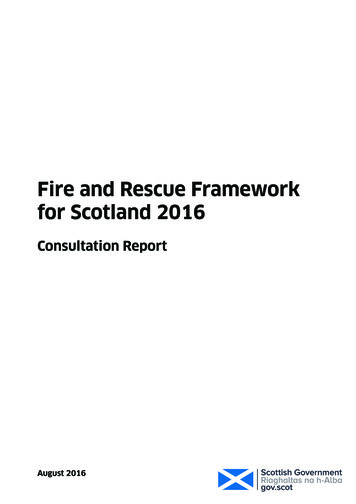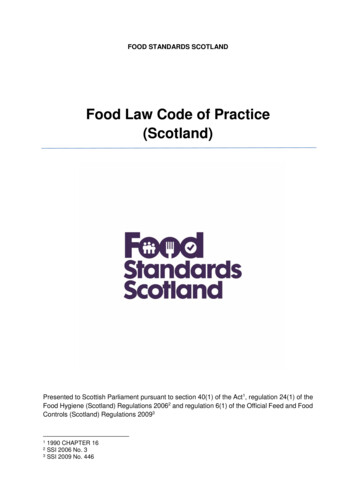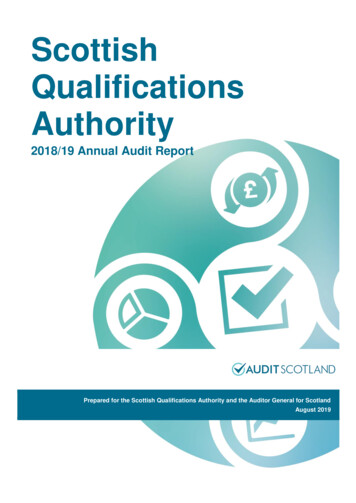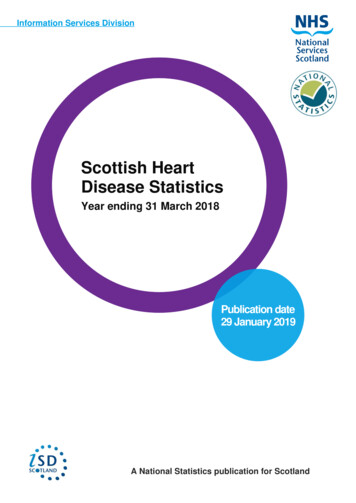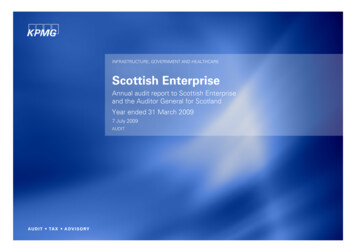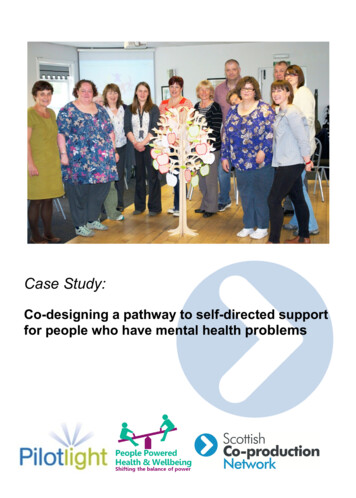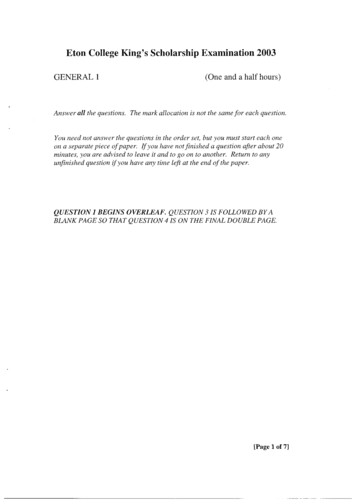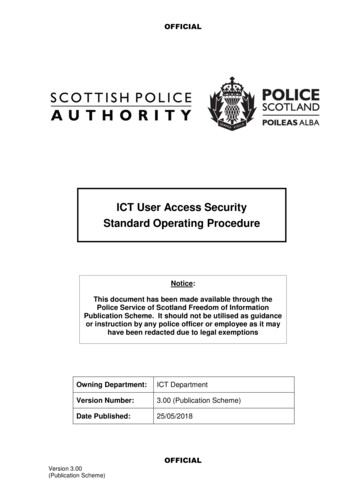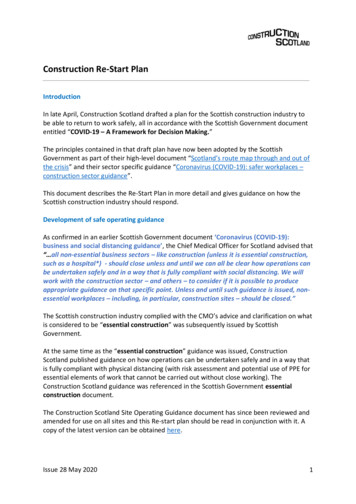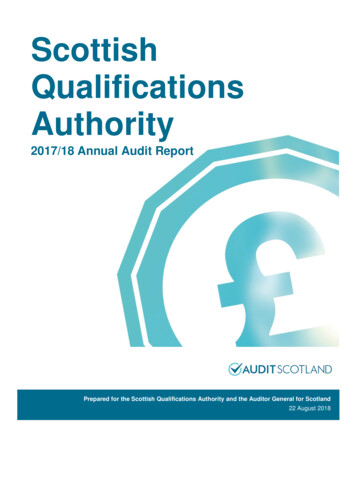
Transcription
ScottishQualificationsAuthority2017/18 Annual Audit ReportPrepared for the Scottish Qualifications Authority and the Auditor General for Scotland22 August 2018
Who we areThe Auditor General, the Accounts Commission and Audit Scotland work togetherto deliver public audit in Scotland: The Auditor General is an independent crown appointment, made on therecommendation of the Scottish Parliament, to audit the ScottishGovernment, NHS and other bodies and report to Parliament on theirfinancial health and performance. The Accounts Commission is an independent public body appointed byScottish ministers to hold local government to account. The Controller ofAudit is an independent post established by statute, with powers to reportdirectly to the Commission on the audit of local government. Audit Scotland is governed by a board, consisting of the Auditor General,the chair of the Accounts Commission, a non-executive board chair, andtwo non-executive members appointed by the Scottish Commission forPublic Audit, a commission of the Scottish Parliament.About usThrough our work for the Auditor General and the Accounts Commission, weprovide independent assurance to the people of Scotland that public money isspent properly and provides value. We aim to achieve this by: carrying out relevant and timely audits of the way the public sector managesand spends money reporting our findings and conclusions in public identifying risks, making clear and relevant recommendations.
Scottish Qualifications Authority: 2017/18 Annual Audit Report 3ContentsKey messages4Introduction5Part 17Audit of 2017/18 annual report and accountsPart 211Financial sustainability and governance statementAppendix 116Action plan 2017/18Appendix 218Significant audit risks identified during planningAppendix 3Summary of national performance reports 2017/1820
4 Key messages2017/18 annual report and accounts1 The SQA’s financial statements give a true and fair view of its state ofaffairs and its net expenditure for the year.2The audited part of the Remuneration and Staff Report, PerformanceReport and Governance Statement were all consistent with the financialstatements and properly prepared in accordance with guidance.3The overall impact of the adjustments to the accounts was to increasethe general reserve by 1.361 million.Financial sustainability and governance statement4SQA contained its net spending within the budget allocated by theScottish Government.5Net assets increased by 28.867 million to 15.301 million, principallydue to a reduction in the estimated pension deficit.6 Systems of internal control operated effectively in 2017/18 with scope forimprovement in some areas.
Introduction 5Introduction1. The scope of our audit was set out in our Annual Audit Plan presented to theMarch 2018 meeting of the Audit Committee.2. This report sets out our findings from: the audit of the SQA’s annual report and accounts consideration of financial sustainability and governance statement.3. The management of the SQA is responsible for ensuring the proper stewardshipof public funds. This responsibility includes, inter alia: preparing financial statements which give a true and fair view in accordancewith the HM Treasury Financial Reporting Manual (FReM) and the ScottishPublic Finance Manual (SPFM). ensuring the regularity of transactions by putting in place systems of internalcontrol maintaining proper accounting records and appropriate governancearrangements preparing a Whole of Government Accounts return.4. Our responsibilities as independent auditor are established by the PublicFinance and Accountability (Scotland) Act 2000 and the Code of Audit Practice2016, and guided by the auditing profession’s ethical guidance.5. We undertake our audit in accordance with International Standards on Auditing,the principles contained within the Code of Audit Practice. At the conclusion of ouraudit, we provide an Independent Auditor’s Report for inclusion in the AnnualReport and Accounts. The Independent Auditor’s Report sets out our opinions on: whether the financial statements give a true and fair view of the state of theaffairs of SQA and of the net expenditure for the year whether the Annual Accounts have been properly prepared in accordancewith the FReM whether the Annual Accounts have been prepared in accordance with therequirements of the Public Finance and Accountability (Scotland) Act 2000and the Education (Scotland) Act 1996 and directions made thereunder bythe Scottish Ministers the regularity of the expenditure and income other matters as directed by the Auditor General6. An audit of the Annual Accounts is not designed to identify all matters that maybe relevant to those charged with governance. We have included in this report onlythose matters that have come to our attention as a result of our normal auditprocedures; consequently, our comments should not be regarded as acomprehensive record of all deficiencies that may exist or improvements that couldbe made.
6 7. It is the auditor's responsibility to provide an Independent Auditor’s Report on theAnnual Accounts prepared by management, with the oversight of those chargedwith governance. This does not relieve management of responsibility for thepreparation of the annual report and accounts.8. Our annual audit report contains an agreed action plan (appendix 1). No newactions were identified from the 2017/18 audit; however, we have updated theaction plan points brought forward from 2016/17. The Audit Committee shouldensure that they are satisfied with proposed actions and have adequatemechanisms in place to assess progress and monitor outcomes.9. We confirm that we comply with the Financial Reporting Council’s EthicalStandard. We have not undertaken any non-audit related services and thereforethe 2017/18 audit fee of 46,280, as set out in our Annual Audit Plan, remainsunchanged. We are not aware of any relationships that could compromise ourobjectivity and independence.Adding value through the audit10. Our aim is to add value to the SQA by providing insight and foresight onfinancial sustainability and by identifying areas of improvement and encouraginggood practice. In so doing, we aim to help the SQA promote improved standards offinancial planning, management and decision making.Concluding remarks11. This report is addressed to both the SQA and the Auditor General for Scotlandand will be published on Audit Scotland's website www.audit-scotland.gov.uk in duecourse.12. The cooperation and assistance afforded to the audit team during the course ofthe audit is gratefully acknowledged.
Part 1 Audit of 2017/18 annual report and accounts 7Part 1Audit of 2017/18 annual report and accountsMain judgementsThe SQA’s financial statements give a true and fair view of its state of itsaffairs and its net expenditure for the year.The audited part of the Remuneration and Staff Report, PerformanceReport and Governance Statement were all consistent with the financialstatements and properly prepared in accordance with guidance.The overall impact of the adjustments to the accounts was to increasethe general reserve by 1.361 million.Audit opinions on the annual report and accounts13. The SQA’s Annual Report and Accounts for the year ended 31 March 2018 wasapproved by the Board of Management on 22 August 2018.14. We reported in our Independent Auditor’s Report: an unqualified opinion on the financial statements an unqualified opinion on regularity of expenditure and income the audited part of the Remuneration and Staff Report, Performance Reportand Governance Statement were all consistent with the financial statementsand properly prepared in accordance with the accounts direction we have nothing to report in respect of those matters which we are requiredby the Auditor General to report by exception.Submission of annual report and accounts for audit15. We received the unaudited Annual Report and Accounts on 14 May 2018 in linewith the agreed audit timetable.16. The unaudited Annual Report and Accounts provided for audit were completeand of a good standard. The finance staff provided good support to the audit teamwhich helped ensure that the final accounts audit process ran smoothly.Whole of Government Accounts17. Whole of government accounts (WGA) are the consolidated financialstatements for all components of government in the UK. The SQA is required toprovide information for the preparation of WGA and external auditors are requiredto review and provide assurance on the WGA return. The SQA submitted its WGAreturn by the deadline. We reviewed the return and submitted the requiredassurance statement to the National Audit Office (NAO) within the specifieddeadline.The annual reportand accounts arethe principalmeans ofaccounting for theSQA’sstewardship ofresources and itsperformance inthe use of thoseresources.
8 Risk of material misstatement18. The concept of audit risk is of central importance to our audit approach. Duringthe planning stage of our audit we identified a number of key audit risks whichinvolved the highest level of judgement and potential impact on the financialstatements. We set out in our Annual Audit Plan the audit work we proposed toundertake to secure appropriate levels of assurance. Appendix 2 sets out thesignificant audit risks identified and how we addressed each risk in arriving at ouropinion on the financial statements.Materiality19. Materiality can be defined as the maximum amount by which auditors believethe financial statements could be misstated and still not be expected to affect theperceptions and decisions of users of financial statements. The assessment ofwhat is material is a matter of professional judgement. A misstatement or omission,which would not normally be regarded as material by value, may be important forother reasons (for example, an item contrary to law).20. Our initial assessment of materiality for the financial statements wasundertaken during the planning phase of the audit. We assessed the materiality ofuncorrected misstatements, both individually and collectively in forming our opinionon the financial statements.21. On receipt of the Annual Report and Accounts and following completion of audittesting, we reviewed our original materiality calculations and concluded that theyremained appropriate. Materiality on receipt of the unaudited financial statementsis summarised at exhibit 1.Exhibit 1Materiality levelsMateriality levelAmountOverall materiality 807,000Performance materiality 404,000Reporting thresholdSource: Audit Scotland Annual Audit Plan 2017/18How we evaluate misstatements22. It is our responsibility to request that all misstatements, other than those belowthe reporting threshold, are corrected. The final decision on this lies with thosecharged with governance considering advice from senior officers and materialitylevels.23. Management made adjustments for all monetary misstatements whichexceeded the reporting threshold. As a result of these changes the net balance inthe expenditure for the year recognised in the Statement of Comprehensive NetExpenditure reduced by 0.734 million and the balance of the General Fund shownin the Statement of Changes in Taxpayers’ Equity has increased by 1.361 million.This resulted in net liabilities shown in the Statement of Financial Position reducingby 1.361 million. Exhibit 2 sets out the impact of the only two misstatements ofsignificance. 32,000
Part 1 Audit of 2017/18 annual report and accounts 9Exhibit 2Evaluation of misstatementsMisstatementImpactTrade and other payables overstated by 1.095millionCurrent liabilities reduced by 1.095 million.Deferred income from 2015/16 of 0.920 millionwas not credited until 2017/18Total comprehensive net expenditure for theyear reduced by 0.920 million.Reserves increased by 1.095 million.Significant findings from the audit (ISA 260)24. International Standard on Auditing (UK) 260 requires us to communicatesignificant findings from the audit to those charged with governance. These aresummarised in exhibit 3. Where a finding has resulted in a recommendation tomanagement, a cross reference to the Action Plan (appendix 1) has been included.25. The findings include our views about significant qualitative aspects ofaccounting practices including: significant financial statements disclosures, theimpact of any uncertainties, misstatements in the Annual Report and Accounts,accounting estimates and judgements, and the effect of any unusual transactionson the financial statements.Exhibit 3Significant findings from the audit of the financial statementsFindingResolution1. Scottish Government Capital FundingSQA receive a capital allocation from the ScottishGovernment. Although capital expenditure was incurredduring the year, the capital funding was not drawn down until26 March. During the year, expenditure of a capital nature( 1.095 million) was made from revenue. All capitalexpenditure made in year is included as additions to noncurrent assets. The corresponding (capital) income from theScottish Government was categorised as ‘deferred capitalincome’ as some of the assets have not been brought intouse; this has had the effect of reducing the Statement offinancial position.Management have adjusted the financialstatements to correct the position.2. Deferred income balanceA capital allocation ( 0.920 million) had been received fromthe Scottish Government in 2015/16 and held as a ‘deferredincome’ balance as it had not been allocated to a specificnon-current asset. The accounting transaction to correct thislegacy issue was incorrect as it was taken directly to theStatement of Cash Flows rather than through the expenditurenote.Management have adjusted the financialstatements to correct the position.
10 FindingResolution3. Staff ReportThe FReM stipulates the information to be disclosed in theStaff Report. There were a number of omissions from theStaff Report submitted as part of the unaudited AnnualReport and Accounts.Management agreed to amend the StaffReport and are working on a template thatidentifies the information that requires tobe disclosed.3. Revised estimate of net pension liabilityInternational Accounting Standard 19 – Employee Benefitsrequires all organisations to disclose information on pensionliabilities in their financial statements. Each year theStrathclyde Pension Fund actuary provides a report to theSQA to allow the appropriate entries to be made to thefinancial statements. The actuarial estimate of the pensionfund’s assets at 31 March 2018 was underestimated (furtherexplained at paragraph 47). As a consequence, the SQAshare of the pension fund assets was understated in theactuary’s report. This resulted in an overstatement of theSQA’s net pension liability by 2.814 million.Management requested a recalculation ofthe SQA’s pension liability from theStrathclyde Pension Fund actuary andhave adjusted the financial statements toamend the position.Source: Audit ScotlandOther findings26. In addition to the issues set out above, and in accordance with normal auditpractice, a number of presentational and disclosure amendments were discussedand agreed with management.Follow up of prior year recommendations27. We have followed up actions previously reported and assessed progress withimplementation, these are reported in appendix 1 and identified by the prefix b/f(brought forward).28. In total, nine agreed actions were raised in 2016/17. Of these: five have been fully implemented four have not yet been actioned or are partly actioned29. Overall the SQA has made good progress in implementing these actions. Forthose actions not yet implemented, revised responses and timescales have beenagreed with management at appendix 1.
Part 2 Financial sustainability and governance statement 11Part 2Financial sustainability and governance statementMain judgementsSQA contained its net spending within the budget allocated by theScottish Government.Net assets increased by 28.867 million to 15.301 million, This wasprincipally due to a reduction in the estimated pension deficit.Systems of internal control operated effectively in 2017/18 with scope forimprovement in some areas.Financial performance in 2017/1830. The SQA’s budget sets out the level of funding required from the ScottishGovernment. The amount of funding allocated by the Scottish Government istermed the Departmental Expenditure Limit (DEL). The SQA receives an annualallocation of “resource” DEL to fund current expenditure, and “capital” DEL to fundinvestment in assets. Resource DEL is further split into cash and non-cash(ringfenced) elements.31. The main financial objective for the SQA is to ensure that the financial outturnfor the year is within the agreed budget and the DEL allocated by the ScottishGovernment.32. The SQA had an underspend of 1.904 million on a budget of 32.433 millionin 2017/18. The underspend was partly attributable to an unexpected increase incommercial income at the end of the year. In light of this, management havereviewed the budgeted income figure for 2018/19 and made an adjustment toreflect previous years’ income profiles. The financial performance against theDepartmental Expenditure Limit is shown at exhibit 4.33. Depreciation and impairment are accounting concepts that reflect the cost ofuse of non-current assets within organisations’ financial statements. ScottishGovernment budget allocations recognise these non-cash costs as “ringfenced”DEL. The SQA did not use its ringfenced DEL allocation in 2017/18; non-cashcosts were funded by non-ringfenced resource DEL.2017/18 financial position34. The Statement of Financial Position summarises what is owned and owed byand to the SQA. The Statement of Changes in Taxpayers' Equity shows taxpayers’equity which is an accounting measure of the amount invested that has continuingpublic benefit.35. The financial statements show that the SQA has net assets of 15.301 million,mainly representing net current assets. This is an increase of 28.867 million fromthe previous year. This was principally due to the reduced actuarial estimate ofSQA’s future pension obligations in respect of the Local Government PensionScheme – see paragraph 42 below.Financialsustainabilitylooks forward tothe medium andlonger term toconsider whetherthe body isplanningeffectively tocontinue todeliver itsservices or theway in which theyshould bedelivered.
12 Exhibit 4Performance against Departmental Expenditure Limit (DEL) in 2017/18PerformanceResource DELCapital DELTotal DELRing-fenced DELTotalInitial DELFinal DEL mActualdrawdown m(Underallocation) m 29(1.904)Source: SQA audited Annual Report and Accounts and Budget Allocation and Monitoring letter 2017/18Short term financial planning36. The SQA generates income from fees and charges but relies on the ScottishGovernment providing deficit funding. A significant factor in the SQA’s operating netexpenditure deficit is the funding model for levying charges for nationalexamination entries. It is the policy of the Scottish Government to keep chargesfrozen at 2010/11 levels and provide deficit funding to meet the shortfall in the SQAcosts.37. In 2017/18, entry fees and other income generated 48.728 million accountingfor 62% of total income. Funding from the Scottish Government ( 30.529 million)accounted for 32% of total income.38. The Board of Management approved SQA’s 2018/19 draft budget in December2017. The budget forecasts a breakeven position after Scottish Governmentfunding is included. The budget sets out the level of funding required from theScottish Government for 2018/19 at 31.925 million ( 30.264 million resource andring-fenced DEL and 1.661 million capital DEL). The initial budget allocationmonitoring letter set out an initial allocation of 11.017 million.Medium to long term financial planning39. We reviewed the financial planning systems and assessed how effective theyare in identifying and addressing risks to financial sustainability across the mediumand long term.40. The SQA has a Corporate Plan covering 2018-2021, which includes a financialplan covering the period 2018/19 based on the assumed level of funding andestimated costs against each of its strategic objectives.41. One of the challenges for the SQA is the short term financial planning cycle ofthe Scottish Government and the resulting difficulty in preparing medium/longerterm funding strategies to address its priorities. While this is an obstacle to precisefinancial planning, management should prepare a 3-5 year rolling budget usingwhat information is available and incorporating sensitivity analysis and scenarioplanning. In the absence of medium to long term financial planning, the futurefinancial risks facing the SQA may not be clearly understood. In this respect weunderstand that there is a continuing dialogue between the SQA and ScottishGovernment on agreeing a future sustainable financial model.
Part 2 Financial sustainability and governance statement 13Pension liability42. A significantly reduced pension liability of 7.998 million (2016/17 36.336million) has been included in the Statement of Financial Position. This section isincluded for information to non-executive directors as we consider that the largemovement requires explanation and comment.43. The pension liability represents the difference between expected futurepayments to pensioners and the underlying value of pension fund assets availableto meet this liability.44. The SQA is an admitted member of Strathclyde Pension Fund, one of thelargest in the UK. Valuation of pension fund assets and liabilities is assessed by anindependent firm of actuaries (Hymans Robertson LLP). Annual valuations aredependent on a number of external variables, including projected rates of return onassets, projected rates of price and pay inflation, interest rates and mortalityestimates.45. Over the past decade there has been considerable volatility in the valuation ofpension liabilities across the public sector. For the SQA, the movement over thepast seven years is set out at exhibit 5. Small changes in actuarial assumptionscan have a significant impact on the calculation of closing liabilities.46. The pension fund actuary has provided information on the variables which hadthe greatest impact on the calculation of the 31 March 2018 liability. Note 3 to thefinancial statements provides further details.Exhibit 5SQA movement in net pension liability 2011/12 - 2017/18Source: Audit Scotland47. International Accounting Standard 19 – Employee Benefits requires allorganisations to disclose information on pension liabilities in their financialstatements. Pension disclosures are provided annually to participating bodies bythe Strathclyde Pension Fund actuary. Actuarial reports are produced in advance ofthe year end, by calculating an asset valuation prior to the year end and estimatingthe results for the final months of the year. There was a significant differencebetween the estimated value of the assets at the year end and the actual outturnreported in the annual accounts of Strathclyde Pension Fund. This error was onlyaround 2.5%, however, when applied to the asset share of individual bodies thedifferences become material. In the case of the SQA this required an amendmentresulting in the reduction of the net pension liability by 2.814 million.
14 Systems of internal control48. As part of our 2017/18 audit we identified and tested key controls operating inthe main accounting systems. Our objective was to gain assurance that the SQAhas systems of recording and processing transactions which provide a sound basisfor the preparation of the financial statements.49. We concluded that, generally, controls were operating satisfactorily. However,we have suggested enhancements to controls and processes in the interimmanagement letter, and in this report, which would strengthen the internal controlenvironment.50. During the year the SQA’s Fraud Response Team was made aware of apotential financial irregularity. The matter is still under investigation. We will monitorthe outcome of the investigation and comment in future reports as appropriate.Governance statement51. We reviewed the assurances which were provided to the Chief Executive asAccountable Officer by the Executive Management Team regarding the adequacyand effectiveness of the system of internal control.52. Several risks are set out in the governance statement. These include issuessuch as financial sustainability risk and workforce issues. The statement alsosummarises internal audit findings and key reports issued in the year.53. We concluded that the information in the governance statement is consistentwith the financial statements and complies with guidance issued by the ScottishMinisters.Internal audit54. Internal audit provides the Board of Management, the Accountable Officer andthe Executive Management Team with independent assurance on SQA’s overallrisk management, internal control and corporate governance processes. Theinternal audit function is carried out by Scott-Moncrieff.55. We undertook a central review of the adequacy of internal audit and concludedthat it operates in accordance with the Public Sector Internal Audit Standards(PSIAS) and has sound documentation standards and reporting procedures inplace.56. To avoid duplication of effort we place reliance on the work of internal auditwherever possible. In 2017/18 we placed formal reliance on the review of datamigration following the implementation of the new ledger system during 2017. Also,internal audit reviews were considered to gain an understanding of processes andsystems and as part of our wider dimension work.57. The annual internal audit opinion, required by PSIAS and reported to the Maymeeting of the Audit Committee, concluded that the SQA has a framework ofcontrols in place that provides reasonable assurance regarding; the organisation’sgovernance framework, effective and efficient achievement of objectives, and themanagement of key risks.General Data Protection Regulation58. The EU General Data Protection Regulation (GDPR) came into force across allmember states on 25 May 2018. GDPR contains provisions and requirementspertaining to the processing of personally identifiable information and hasintroduced new and significantly changed data protection concepts.59. Management have advised that the SQA has put in place arrangements tomake themselves compliant with the requirements of the new regulations.
Part 2 Financial sustainability and governance statement 15However, further work is being undertaken to ensure that all processes andprocedures across the business are as efficient and transparent as possible.National performance audit reports60. Audit Scotland carries out a national performance audit programme on behalfof the Accounts Commission and the Auditor General for Scotland. In 2017/18several reports were published which are of direct interest to the ScottishQualifications Authority. These are summarised at appendix 3.
16 Appendix 1Action plan 2017/18No.Issue/riskRecommendationAgreed managementaction/timingFollow up of prior year recommendationsb/fThe current budget processdoes not include medium tolong term financial planning.RiskIn the absence of medium tolong term financial planningthe future financial risks facingSQA may not be clearlyunderstood.b/fImprovements could be madeto enhance engagement withthe wider stakeholdercommunity.RiskAlthough the short termfinancial planning cycle of theScottish Government is anobstacle to precise financialplanning, management shouldprepare a 3-5 year rollingbudget using what informationis available, incorporatingsensitivity analysis andscenario planning asnecessary.A first draft of the medium termfinancial plan is completed andwill be discussed withExecutive Directors and keystakeholders.SQA should consider whetherstakeholder engagement couldbe achieved through promotionof attendance at meetingsand/or the use of technology toreach a wider audience.This is under considerationwith discussions at anadvanced stage to take afuture Board meeting toDundee and Angus College.SQA is seen as having areduced commitment toopenness and transparency.b/fSQA should have systems andprocesses to ensure that it candemonstrate that it isdelivering Best Value byassessing and reporting on theeconomy, efficiency,effectiveness and equality inservice provision.Head of FinanceDecember 2018Chief ExecutiveDecember 2018SQA should undertake aperiodic formal review of itsperformance against theScottish Government BestValue framework.RiskThe organisation is missingopportunities to enhanceservice deliveryA formal Benefits RealisationGroup has been establishedwhich is chaired by theDirector of Finance. This groupreports on benefits achieved,VFM initiatives beingundertaken and strategicinitiatives that will deliver longterm benefits. As part of therolling programme this groupwill review performanceagainst the ScottishGovernment Best ValueFramework.Head of FinanceDecember 2018b/fKPIs are used to monitorprogress against strategicgoals. Updates on progressare regularly submitted to theKPIs should be reported to theBoard of Management atregular intervals.The KPIs will be submitted tothe Board of Management inFY 18/19Chief Executive
Appendix 1 Action plan 2017/18 17No.Issue/riskAudit Committee but not to theBoard of Management.RiskThere is a risk that not allNEBMs are receiving sufficientinformation to enable them toeffectively scrutinise andchallenge performance.RecommendationAgreed managementaction/timingClosed
18 Appendix 2Significant audit risks identified during planningThe table below sets out the audit risks we identified during our planning of theaudit and how we addressed each risk in arriving at our conclusion. The risks arecategorised between those where there is a risk of
Part 1 Audit of 2017/18 annual report and accounts 7 Part 1 Audit of 2017/18 annual report and accounts Audit opinions on the annual report and accounts 13. The SQA's Annual Report and Accounts for the year ended 31 March 2018 was approved by the Board of Management on 22 August 2018. 14. We reported in our Independent Auditor's Report:
